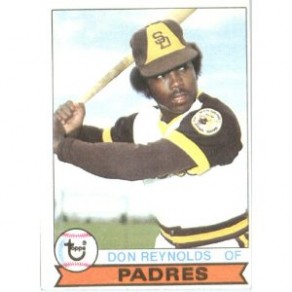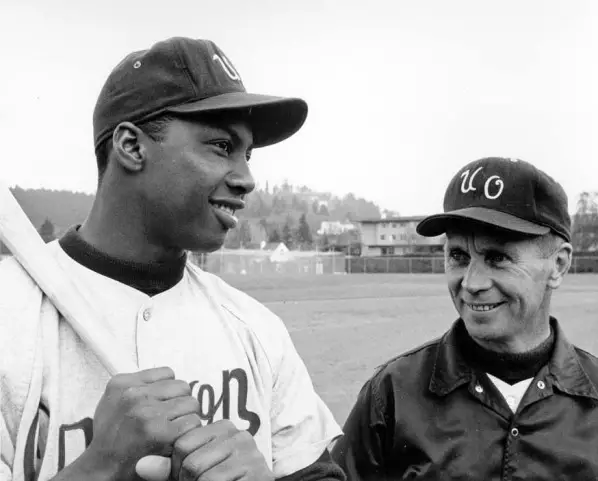
H.D. Murphy (left) and Don Kirsch (right). Murphy was a star in both sports, drafted by the Dallas Cowboys. University of Oregon Libraries – Special Collections and University Archives
Oregon’s baseball team fell just short of making it to the 2012 College World Series this week, a win against Kent State on Monday would have earned Oregon its first trip to the College World Series since 1954. Unfortunate that Oregon couldn’t advance as it may be, it still is a remarkable feat to host a Super Regional in just the fourth year since being reinstated as a sport at the University of Oregon following a 26-year hiatus.
Oregon is a school rich in tradition with multi-sport athletes, from its earliest days to present teams, often great Oregon athletes can be seen during the year in more than just one uniform. But not baseball, Oregon’s diamond Ducks don’t compete in other sports (with the exception of Vernell Warren, who ran track and completed his eligibility this year as an outfielder). This is an oddity with the crossover potential of elite Oregon athletes today. This wasn’t always the case though, particularly football players over the years, many of Oregon’s student-athletes shined both on the gridiron and the diamond.
There has been the possibility of two-sport athletes choosing both in the time since baseball returned to the UO, as speedy WR recruit Braxton Lane intended to play both sports after committing to the Ducks a few years back, but chose to play minor league baseball instead. Beyond Lane, while rumors and rumblings swirl about the possibility of athletes pursuing multiple sports emerge on messageboards, none have come to fruition that intended to play both football and baseball.
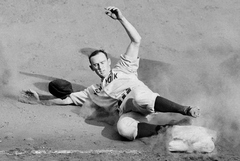
Joe “Flash” Gordon was a multi-sport athlete at Oregon, then went on to a hall of fame career with the Cleveland Indians.
The two sports have a long tradition at Oregon, both in individual talents and team achievements. Oregon football boasts six NFL Hall of Famers, while Oregon baseball has one member in the MLB Hall of Fame (Joe Gordon—who according to Wikipedia was a halfback for the football team, as well as participating in gymnastics, soccer, and track, but these facts could not be verified at this time).
Oregon football has reached the national championship game once (2010-11), while baseball has also made it to the College World Series once (1954).
However when baseball was reduced to a club sport following the 1981 season, it cut off the opportunity to pursue both sports for many who could have potentially shined on Oregon’s diamond given the chance to do so. Some athletes cited the lack of an opportunity to pursue both sports as a reason not to come to Oregon, such as quarterback Jake Locker, who ended up at Washington.

Oregon quarterback Dennis Dixon played minor league baseball in 2007 before his memorable Heisman Trophy-worthy senior campaign
Much was made of quarterback Dennis Dixon’s decision to leave after the 2006 season following his junior year to play minor league baseball with the Atlanta Braves farm system, though he returned for his senior campaign, and was the front-runner for the Heisman trophy until a knee injury sidelined him. His choice to leave left many fans angered, saying good riddance hoping Brady Leaf would emerge as the new starter, though Dixon quickly shut up any grumblings with his stellar play in 2007.
Other athletes came to Oregon to play football after spending time in the minor leagues, most notably linebacker Matt Smith and quarterback Akili Smith. Both spent several years involved in baseball, earning large signing bonuses, before giving college a try, and both proving to be phenomenal football players and leaders for the Ducks during their years.
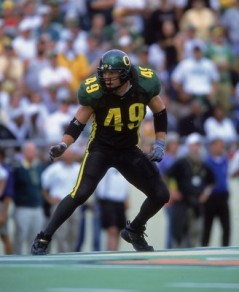
Matt Smith played several years in the minor leagues with the Kansas City Royals farm system before coming to Oregon.
With so much crossover in other sports, what is it that is preventing baseball from including a football player or two today? is it the time conflicts? Certainly spring ball would be a direct interference in the heart of baseball season, but it doesn’t prevent some choosing to also run track, those seasons overlapping. Current freshman defensive lineman Arik Armstead intends to play basketball while at Oregon, despite those seasons conflicting in November.
Certainly skills utilized on the football field are also applicable to aspects of baseball, so why have none crossed over to the diamond in the time since baseball was reinstated? It may just be a matter of time before an Oregon athlete chooses to pursue both, but they wouldn’t be the first. In fact, Oregon’s history is littered with athletes playing football and baseball simultaneously. Here are just a few that have achieved success on both fields of competition.
The 26-year absence of baseball at Oregon from 1982-2008 meant that the last Oregon football players to also play baseball were Greg Moser and James Nutt, during the 1980 and 1981 baseball seasons. Many fans may remember Greg Moser as an outstanding wide receiver from 1979 to 1982 for the Ducks, who then went on to play in the USFL with Los Angeles, Memphis, and Houston before returning to Oregon as a broadcaster. In 1979 two additional football players also participated in baseball, Mike Babb and Rick Ward.
The 1975 baseball team in particular was quite notable, with four football players on its roster, the most well-known being Don Reynolds. Don was an outstanding running back on the football team, rushing for over 1,000 yards in 1973, however it was on the baseball diamond that Reynolds had his greatest success. Reynolds played baseball for Oregon from 1972 to 1975, during which time he was named All-PAC 8 Northern Division outfielder in 1973, 1974, and 1975, winning the Don Kirsch Memorial Award in ’73. Don Reynolds still holds Oregon’s career record for runs, and is near the top of every career offensive category.
Following his career at Oregon, Reynolds was drafted by the San Diego Padres, making it to the majors in 1978 and ’79. Reynolds concluded his professional baseball career with the Spokane Indians in 1981, where he had the opportunity to play alongside his younger brother, Harold Reynolds, who would go on to play second base for the Seattle Mariners for many years. Harold Reynolds today remains a prominent baseball broadcaster, previously with ESPN, now with the MLB Network.
Don Reynolds wasn’t the only outstanding player on the 1975 baseball team, as wide receiver Pat McNally also was on the baseball roster for the Ducks during those years. Prior to coming to Oregon, Pat had been drafted by the Los Angeles Dodgers, but opted to play football and baseball for the Ducks instead. In 1975, McNally was named the All-PAC 8 Northern Division first baseman.
Signed by the Angels after graduating, McNally played one season of minor league ball in 1975 with the Idaho Falls Angels, but didn’t pursue it further. Other football players on the ’75 baseball team included Hank Love (linebacker) and Steve Donnelly (safety).
The year Reynolds and McNally started their dual-varsity athletic careers (1972) was Greg Brosterhous‘ last year at Oregon. Brosterhous played both safety and defensive end during his football career, unheard of in today’s fast-paced and brutal gridiron game. A diverse athlete, as a baseball player he manned Oregon’s outfield from 1970 to 1972, being named All-PAC 8 Northern Division outfielder his senior year.
Others included Dave Pieper and Steve Rennie in 1971, and quarterback Harvey Winn, one of four Winn’s to have played football for the Ducks over the years (Dick Winn, Harvey Winn, Mark Winn, Eric Winn).
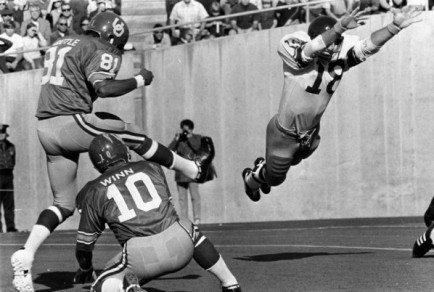
Harvey Winn (#10) played football and baseball while at Oregon, one of four Winn’s to play for the Ducks. ©University of Oregon Libraries – Special Collections and University Archives
Scott Cress was one of the most versatile players on the Ducks’ football team, playing 1965-1967. As a sophomore, Cress played both halfback and cornerback. In 1966, he switched to a wingback/flanker position, and as senior Cress played tight end. On the baseball diamond, Cress was a first baseman from 1966 to 1968. In ’66, he led the Ducks in stolen bases, and two seasons later led Oregon in home runs and RBIs. Among Cress’ football teammates who also played baseball are Eric Olson, Nino Pedrini, Omri Hildreth, Steve Bunker, and Jack Sovereign.
Prior to Scott Cress, Oregon’s football team had another star baseball player on the roster. Junior college transfer H.D. Murphy came to Eugene in 1962. As an Oregon football player he backed up Larry Hill as a halfback, and also played defense.
However, it was on the baseball diamond that Murphy excelled. In 1963 and 1964 Murphy was named All-Coast outfielder, winning the Palmer Award both years. He still holds the Oregon record for career batting average (.381), and the season record for triples (6).
It would have made sense for Murphy to pursue a career in professional baseball, but it was football that instead came calling. He was drafted by the Dallas Cowboys in 1964 along with Oregon teammate Mel Renfro. Unfortunately, H.D. Murphy did not make the Cowboys’ roster, but that didn’t deter him from pursuing the sport further. He signed with the Canton Bulldogs of the United Football League, where he not only played wide receiver but led the league in punt returns.
The Canton franchise moved to Philadelphia in 1965 as part of the new Continental Football League, where Murphy played wide receiver and returned punts for the newly-coined Philadelphia Bulldogs in 1965-66, earning first team All-Star recognition his first year in Philly.
From Philadelphia, Murphy moved on to the short-lived Akron Vulcans (the team only lasted four games) of the Continental Football League in 1967, and concluded his professional career with the Pottstown Firebirds of the Atlantic Coast Football League in 1968. During H.D.’s two seasons at Oregon he was joined on the baseball team by the aforementioned Jack Sovereign, a punter and backup quarterback, and Ron Veres, another quarterback.
H.D. Murphy was a great baseball player at Oregon, but he is perhaps best known for catching the last-second come-from-behind touchdown against the top-10 ranked Indiana Hoosiers at Multnomah Stadium in Portland, OR, November 16th, 1963.

George Shaw was the #1 overall pick in the NFL draft, and Oregon’s only two-time All-American in baseball
The 1950’s were an era in which a number of football players also played baseball for the Ducks. Best known among them is George Shaw, one of the premier athletes in Oregon history. As most fans know, Shaw was a star quarterback and safety during his football career at Oregon, and after being the #1 overall selection in the NFL draft went on to a long career in the NFL and AFL.
However, lesser known is that Shaw was also a star baseball player. He is the only Oregon Duck to be named an All-American twice, in 1954 and 1955. Shaw was also named All-Coast in 1953 as a shortstop, and All-Coast in 1954 and 1955 as an outfielder. Not only leading the way on the gridiron at Hayward Field, Shaw helped lead Oregon to its only College World Series appearance in 1954.
Among his teammates on the 1954 baseball team who also played football were Farrell Albright (halfback) and Don Hedgepeth, an offensive and defensive lineman.
A few of the other football players who also played baseball during the 1950’s include Pete Gumina, Len Read, Donn Taucher, Leroy Phelps, Dick Salter, Joe Tom, and DeWayne Johnson. Read (halfback) played baseball 1956-1959, and holds the all-time Oregon season record for batting average (.426). Joe Tom was a quarterback who was named All-Pacific Coast Conference Northern Division third baseman in 1951.
In fact Oregon’s history books stretch back to the early days of the university, with students achieving in both sports. Bill Steers and Bill Reinhart are among the few athletes at Oregon who lettered in three varsity sports. Bill Steers played football 1916-20, with the exception of the 1918 season in which he played for the Mare Island Marines (during World War I). He wasn’t alone in doing so, as the Mare Island Marines won the East-West Tournament game, led by two other Oregon Webfoots players (John Beckett, Hollis Huntington) and coached by Hugo Bezdek, the Oregon head coach and athletic director.
Steers was a quarterback, guard, kicker, and punter for Oregon, and was named an All-American in 1919, helping lead Oregon to its second East-West Tournament Game (later renamed the Rose Bowl) in four years. Steers played baseball from 1918 to 1920, and basketball during the 1918-1919 season.
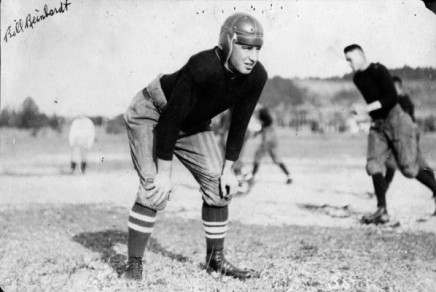
Bill Reinhart was successful in multiple sports as a player and coach at Oregon. ©University of Oregon Libraries – Special Collections and University Archives
Bill Reinhart was not only a three-sport athlete at Oregon, but would go on to coach three sports at Oregon. Reinhart was a football player 1919-1921, a baseball player during those same years, and played basketball for the 1920-1921 season.
Reinhart went on to be an assistant coach for the football team for five seasons, head coach of the baseball team from 1924 to 1935, and head coach of the men’s basketball team from 1923 to 1935. So successful were his basketball teams that the crowds consistently swelled beyond capacity, forcing the university to build a larger venue to house the raucous audience: McArthur Court.
There were many more beyond those listed who performed admirably in both football and baseball during their time in Eugene, the question is when will we see one again? Fans waited 26 years for baseball to return, how many more years must the wait be until a student-athlete chooses to again pursue their athletic aspirations in both sports? Given the demands placed upon football players in this era and the emphasis placed on that sport as the premier revenue sport at Oregon, it may be a while before Oregon football coaches let their athletes pursue baseball as well, which has a schedule that directly conflicts with spring football.
Sure athletes like Dior Mathis and DeAnthony Thomas ran track this year, but not until after spring football ended. Considering that baseball season starts in February, that directly conflicts with the spring football schedule, so perhaps it isn’t as feasible as it once was. Consider though the number of athletes across the country that do both admirably, as well as those who play basketball and football, those seasons also overlapping, so it would not be without precedent in the modern era of high-demand collegiate athletics.
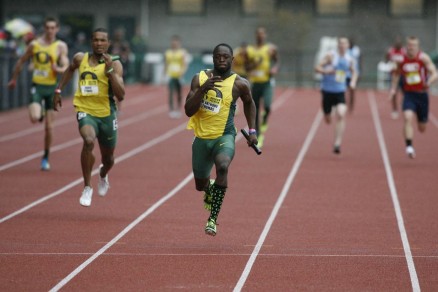
DAT leaving everyone in the dust at the Oregon Track Preview
However, the crowds and emotion at PK Park this past weekend was evident, if for a brief time, showing that Oregon fans had caught baseball fever. The tremendous passion for Oregon sports among Duck fans and athletes isn’t exclusive to Autzen anymore. There’s some magic inside PK Park as well, awaiting the day for those with the talent to achieve within both stadiums to emerge, following in the legacy of the multi-sport stars of Oregon’s past.
Fans waited 26 years for baseball to return, have waited 31 years for a football/baseball dual-athlete, and it’s currently 58 years and counting since the last College World Series appearance. Perhaps versatile dual-sport athlete like George Shaw, Don Reynolds, or H.D. Murphy are the final missing pieces in the jigsaw puzzle before Oregon is truly capable of again reaching the College World Series.
Kurt Liedtke
Klamath Falls, Oregon
Related Articles:
These are articles where the writer left and for some reason did not want his/her name on it any longer or went sideways of our rules–so we assigned it to “staff.” We are grateful to all the writers who contributed to the site through these articles.

